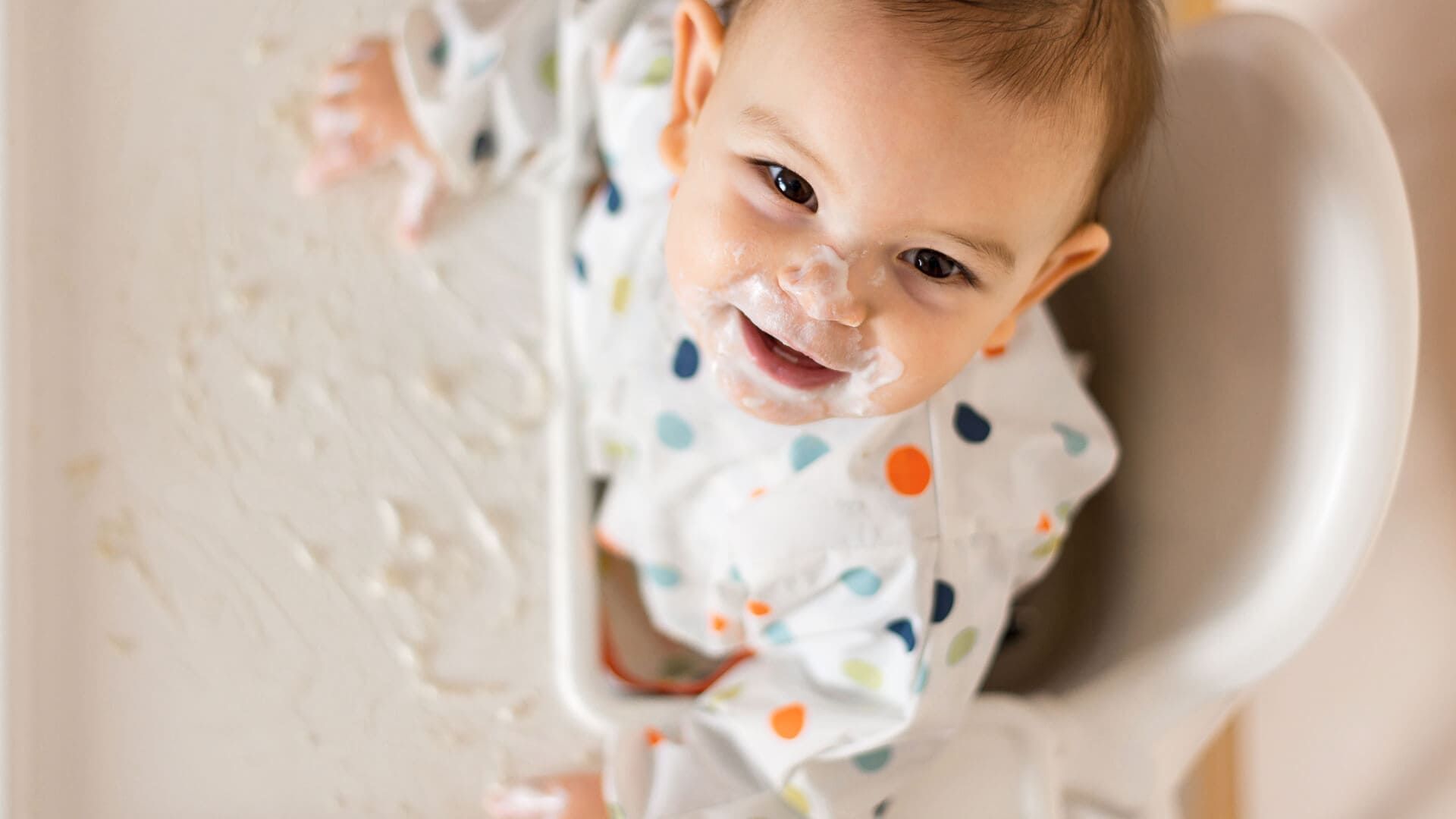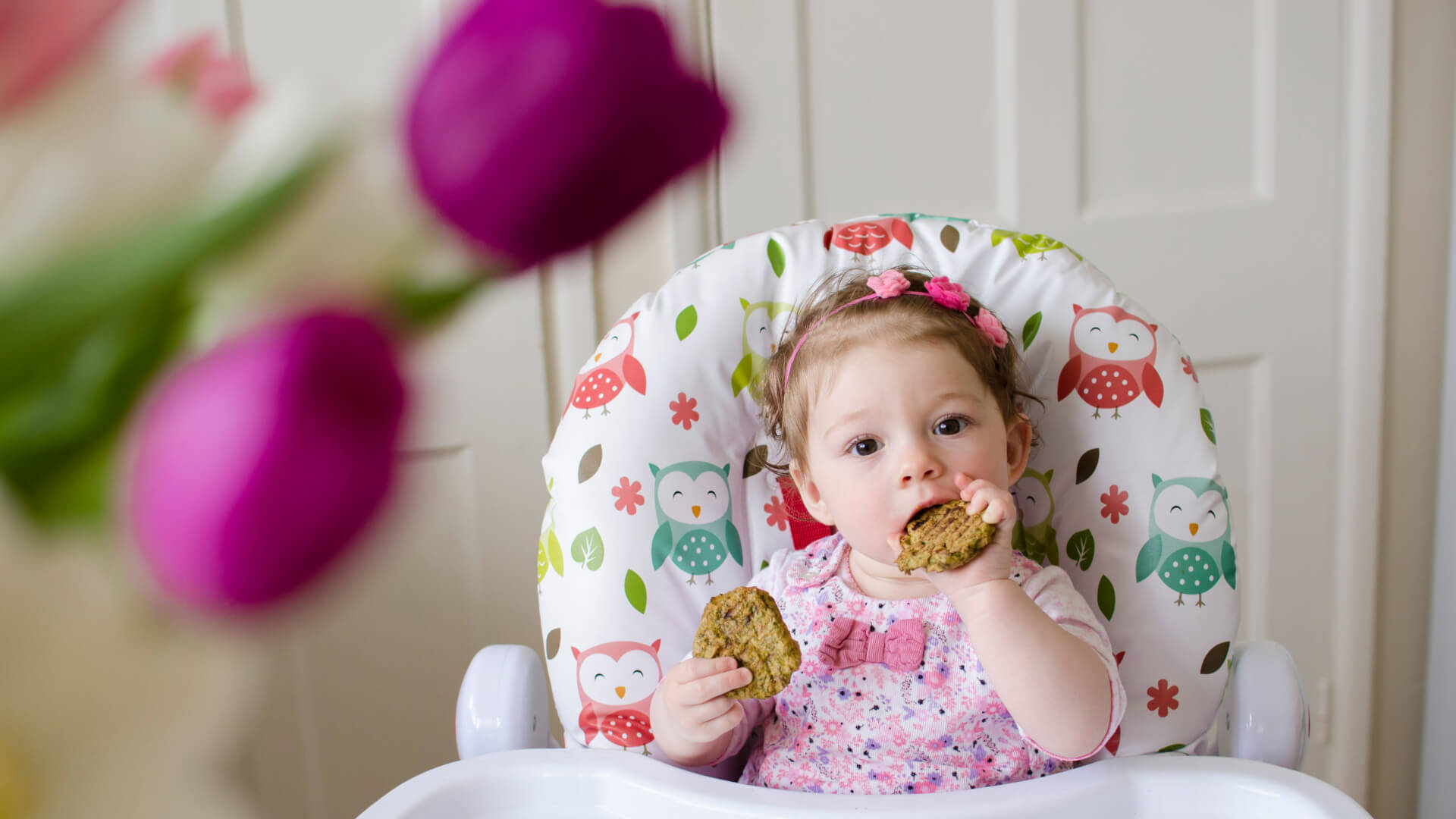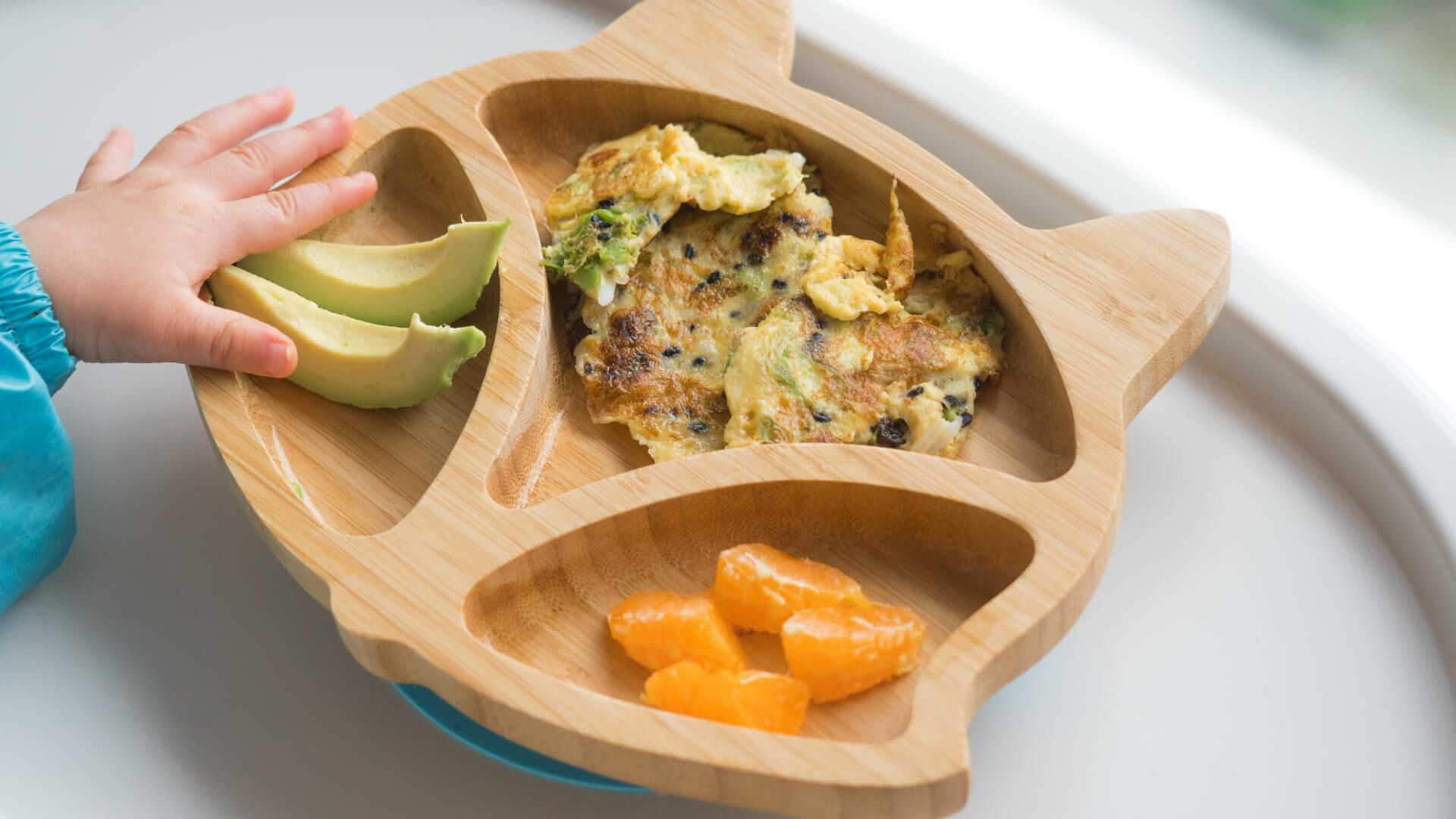Guide to Baby-Led Weaning: Tips, Benefits and Foods

Sarah Johnson, MD

What is baby-led weaning?
Baby-led weaning (term self-attributed to Michael Barrientos) places the emphasis on exploring taste, texture, color and smell as the baby sets their own pace for the meal, choosing which foods to concentrate on. Instead of the traditional method of spooning pureed food into the baby's mouth, the baby takes part in family mealtimes and is presented with a variety of foods in easy-to-grasp pieces, which he or she can freely choose and explore.
When to start baby-led weaning
Experts, including the American Academy of Pediatrics (AAP), now say that the best time to start complementary feeding is about 6 months. By this age, most babies can sit up and grab objects on their own. They also lost the tongue-sticking reflex (which causes them to expel foreign substances from their mouths), plus their intestines developed the necessary digestive enzymes to digest solid food.
Despite the growing popularity of baby-led weaning and its benefits, it differs from traditional methods of introducing solids by feeding the baby mashed potatoes with a spoon (AAP recommends spoon-feeding the baby at the initiative of parents). If you are not sure if weaning under the guidance of a baby is suitable for your child, discuss this idea with your baby's pediatrician.
While most babies will get the green light, some (those with special needs and who cannot pick up and chew food on their own) may not be able to try weaning under the guidance of a child. Then take a closer look at your baby — some people like to take the initiative into their own hands, while others do not.
better with Soula

Support for every woman:
✅ A Personalized Plan to reduce anxiety and overthinking
✅ 24/7 Emotional Support whenever you need it Cycle-Aligned Mental Health Tracking — monitor your mood and symptoms in sync with your period
✅ Real-Time Insights into your energy levels and emotional state
✅ Bite-Sized Exercises to help you return to a calm, balanced state — anytime, anywhere
Tips for Successful Baby-Led Weaning
Set up a safe place to eat
The safest place for a baby to eat is in a highchair. They should be well-supported and able to freely move their arms and hands to reach for food off the tray. Baby’s back should be straight, not reclined. Parents and caregivers should sit facing the baby. As you engage in these frequent lifting and sitting routines with your growing baby, it’s a good idea to stay mindful of your postpartum pelvic floor health to ensure your body feels supported and strong.
Take your time
Give your baby ample time to explore and play with food in the beginning stages. Do what you can to make mealtimes enjoyable and fun for your baby. Do not try to distract your baby while they are eating.
Choose age-appropriate foods
Many parents find BLW appealing because it doesn't call for any particular baby meal. Family meals must, however, be prepared and presented in a child- and safety-friendly manner. Ensure that all food is sufficiently soft to be mashed with two fingers. Start with strips of food, about the size of an adult pinky, and progress to smaller diced foods as your baby’s feeding skills improve.
Offer food without pressure
Just that—led by your infant—is what weaning is all about! It is your responsibility as a parent to offer baby-led weaning meals and chances for self-feeding practice. Your infant has to make the decision about what and whether to eat. Never force food into your baby's mouth or attempt to control how much or how little they eat.
Top 6 Benefits of Baby-Led Weaning
May lower the risk of obesity
Because BLW infants are better at controlling their hunger and fullness cues than other newborns, this strategy may lower the risk of obesity in the future. Actually, research indicates that compared to children who were spoon-fed traditionally, those who were weaned with BLW had a lower BMI and a decreased prevalence of obesity. They were also less likely to eat in response to food stimuli, say being offered a snack at a sporting event if they weren’t hungry.
Exposure to a large variety of foods
Compared to traditional weaning, families that use a baby-led approach are likely to introduce their youngster to a greater variety of meals, including more textures and tastes, even if research on the subject is inconclusive. Eating a wider range of foods is linked to improved diet quality and health results.
Encourages development of motor skills
Self-feeding is a key component of BLW and provides babies with many opportunities to develop and practice both gross and fine motor skills. Exploring and picking up foods on their own increases the number of opportunities babies have to practice strength-building movements.
Reduces parental mealtime stress
One study surveyed mothers' attitudes about using a BLW approach and found that they reported the approach was simple, convenient, and easy to fit into family lifestyles and mealtimes. They also reported less stress around mealtimes and introducing foods to their infants. To further navigate the emotional ups and downs of these parenting milestones, Mental Health AI provides 24/7 support to help you stay calm and confident as your baby grows.
Increases favorable feeding practices
More and more research is examining the role of parental feeding practices on children’s future health outcomes. In general, practicing baby-led weaning may lead to more favorable feeding styles such as being less likely to restrict foods or pressuring children to eat. However, it isn’t clear if parents who choose BLW are just less likely to use negative feeding strategies or if BLW encourages the development of favorable feeding practices.
Saves time and money
You may save time if they are planning to make their own baby foods by simply serving family foods in a safe way. Additionally, the cost of store-bought baby foods tends to be high, so many families notice savings by not having to purchase these foods.

Potential Risks of Baby-Led Weaning
Mealtimes get messy
Infants who start consuming solids are going to get messy — there’s really no way around it! Part of learning to eat involves exploring and playing with food as well as sometimes missing their mouth. So if you are the type that can’t handle a mess, it might not be for you.
To make clean-up easier, feed your baby in just a diaper, invest in wipeable bibs, and a washable splash mat for the floor. Since a full-body cleanup is often necessary after a messy BLW session, having the best bath for your newborn ready can turn post-meal cleaning into a relaxing bonding time.
Family foods may not always be suitable for infants
One of the best things about this method is that it doesn’t require a lot of extra cooking or food preparation. However, not all family foods may be suitable for infants such as fast food or meals with added sugars or salt.
These types of foods may negatively impact infants’ immediate health, and may also set them up to prefer these types of foods later in life. While there’s nothing wrong with enjoying these foods in moderation, keep in mind you’ll need to have another option on hand for your baby.
10 Best Food for Newborns
Avocados
Avocado is chock-full of healthy fats to support your baby’s fast-growing brain, so it’s worth making it a mainstay on her menu once she starts solids.
That’s true whether you're introducing solid foods in the form of purées or are trying a baby-led weaning approach, which involves jumping straight to finger foods as soon as solids are introduced. Avocado's soft, smush-able texture is just right for curious new noshers, and the prep work for you is minimal, since there’s no cooking required.
Bananas
Nutritious, soft, sweet, and easy to prep and eat: When it comes to ideal first foods for your baby, bananas are at the top of the list.
But whether you’re following baby-led weaning or starting solids in the form of purées, you might be wondering about the best way to add bananas to your budding eater’s menu. Chances are, your curious cutie will get a kick out of trying this tasty fruit.
Blueberries
Blueberries might not be the first or second fruit on your baby’s menu. But you can still introduce these sweet, juicy bites relatively early on after your child starts solids, whether you began with spoon-feeding or baby-led weaning. And they’ll likely fast become a favorite.
Broccoli
Chalked full of calcium, fiber and folate — broccoli is also knows for its cancer fighting properties. Steam broccoli to take the bitter taste out and then serve it chilled, it is often accepted more willingly by babies.
Lentils
Loaded with fiber and protein, lentils are an excellent nutritional source and very affordable choice for baby.
Meat
Iron and zinc are both found in meat. Tougher meats, such chuck, stewed in stews long enough to become soft, are among of the finest methods to introduce meat into your baby's diet.
Prunes
Puree prunes to provide your baby with loads of fiber and as needed assistance relieving constipation, which may happen after introducing solids for the first time.
Sweet potatoes
From a baby’s very first solid food to a toddler’s go-to side dish or snack, sweet potatoes fit the bill. Their naturally sweet flavor is a hit with most young eaters, and they’re packed with nutrition that growing tots need.
Whether you're introducing solids in the form of purées or trying a baby-led weaning approach — when babies 6 months or older jump straight to soft, gummable finger foods as soon as solids are introduced.
Winter squash
Orange- or yellow-fleshed hard winter squashes such as butternut, acorn, and pumpkin boast many benefits, one of which is they're exceptionally rich in beta-carotene, recognized for being great for eyes. Squash is also an excellent source of vitamin C. Natural sweetness and a creamy texture add to the appeal of winter varieties.
Yogurt
Rich in calcium and vitamin D, which are essential for strong bones and teeth, is creamy yogurt. It may be given to your infant as early as 4 or 6 months, much before they're ready for cow's milk.
Opt for plain yogurt with no added sugar. Also look for a brand with the most live cultures, which help regulate the good bacteria in your baby's digestive tract. Make sure you pick up whole-milk yogurt – babies need the calories from fat.

Foods to Avoid During Baby-Led Weaning
At times, babies may want to try different foods but be careful to avoid foods that are choke hazards such as:
- Raw, hard vegetables that are difficult to chew
- Cubed or round foods like grapes or sliced, dime-like hotdogs
- Crunchy, hard foods that are heavily textured like chips or popcorn
Introducing Top Food Allergens
In connection with recent studies on the prevention of food allergies, it has become clear that foods that contain a large number of allergens should be introduced into the diet of children from about the age of six months, when they begin to eat solid food. You have the opportunity to start offering potential allergens to your child at an early stage of development, and then continue to introduce them. There may be allergic reactions after the first contact. The case of allergic reactions to food is quite common. To keep an eye on the response, you might want to think about providing foods that are more likely to cause allergies early in the day. Symptoms of an allergic response can include vomiting, diarrhea, and skin rashes.
At the moment, cow's milk, eggs, wheat, peanuts, tree nuts, fish, shellfish, soy, and sesame are the top nine food allergies.
BLW Foods by Age
The charts below represent what a sample day could look like for a baby that age to help you with a weekly meal plan. But remember, you know your baby best and their day may not look exactly like this. Adapt the schedule in a way that works realistically for your family. Family meals are a cornerstone of BLW, so if it is easier to start with dinner instead of breakfast as suggested, do that. Each day might look a bit different and that’s okay too!
6-month baby-led weaning food chart
- Baked or steamed sweet potato strips
- Steamed carrot strips
- Thick avocado slices
- Thick banana slices
- Thick mango or melon slices (peeled)
- Steamed broccoli or cauliflower florets
- Toast strips
- Plain Greek yogurt
- Quartered hard-boiled eggs or omelet strips
- Ricotta cheese
- Mozzarella cheese
- Steamed tofu strips
- Plain puréed beef, turkey or chicken shaped into logs
7 - 9 month baby-led weaning food chart
- Thinly sliced strawberries
- Halved raspberries or blueberries
- Ripe peach or nectarine slices
- Ripe pear slices (steamed or roasted if firm)
- Steamed or roasted apple wedges (skin removed)
- Steamed green beans
- Steamed peas
- Steamed or sauteed chopped spinach
- Grated or cubed Swiss or cheddar cheese
- Whole grain O-s
- Whole wheat pasta
- Minced chicken, turkey or beef
- Halved mini meatballs
- Cooked beans
- Hummus
- Baked or broiled fish fish such as cod, sole or salmon (check to ensure any bones are removed)
- Scrambled eggs
10 - 11 month baby-led weaning food chart
When your child gets closer to turning one, her menu will begin to resemble yours. Now that she's reached this stage, almost everything may be eaten, and she probably can't miss out on much of what the rest of the family is having (as long as it's provided safely, of course). That might look like:
- Whole wheat spaghetti and meatballs, both cut into small pieces, topped with Parmesan cheese.
- Baked fish or chicken, flaked or cut into bite-sized pieces, with roasted sweet potato wedges and steamed broccoli or peas.
- Tacos served deconstructed, with a mound of beans, grated cheese, chopped tomato and soft whole grain tortilla wedges.
- Half of a grilled cheese sandwich, cut into wedges, with a side of tomato soup for dunking.
- Hummus plate with steamed carrot strips or half-moons, thinly sliced and peeled cucumber strips, whole grain pita and sliced cheese.
12+ month baby-led weaning food chart
A 12-month-old infant should be eating three meals a day with solid food and two snacks. Cooked food should be soft enough to chop into small pieces and mash between your fingers. Families might decide to start introducing whole cow's milk or a suitable milk substitute at this age. Discuss what's best for your family with your physician or a pediatric registered dietitian.

FAQs
Is baby-led weaning feasible?
Of course. Many parents find baby-led weaning to be simple and low-stress. By ensuring your baby is served a variety of foods and continuing to offer breastmilk or formula on demand, it’s possible to meet their nutrient needs with a baby-led weaning approach.
What age should I start baby-led weaning?
There are still disputes about the time of the beginning of complementary feeding. But if we bring scientific reasoning to a common denominator, then the conclusion arises that complementary foods can be administered from about six months old, and for children with certain medical indications – from 3-5 months. Many experts believe that six months is the ideal time for complementary feeding, when the first colic is left behind, and the digestive system is sufficiently formed to try new products. Only a pediatrician can give an accurate answer to the question of when to introduce complementary foods for a particular child. In some situations, it may be necessary to introduce new dishes into the baby's diet as early as 4 months, and someone will be ready for this only after six months.
Is there a risk of choking?
Overall, when practiced correctly, baby-led weaning is a safe and effective way to introduce solids to an infant. Research shows no greater risk of choking or nutrient deficiency for this method versus a more traditional weaning style.
Do babies need teeth for baby-led weaning?
When it comes to Baby-Led Weaning, many parents wonder about the role of teeth. Contrary to popular belief, babies do not need teeth to practice self-feeding. Their gums are strong enough to mash and chew soft finger foods. As they continue to explore different textures and practice chewing, the eruption of teeth will further enhance their chewing skills.
How do I know when the baby has had enough?
They are relaxed and content after a feed - if they are still showing hunger signs, they may not be full:
- They push or turn away from the food
- They close their mouth
- They are not interested if you offer more milk and their hands are relaxed and open. If your baby seems content but still seeks the comfort of sucking after a meal, finding the best pacifiers for newborns can help satisfy that reflex without confusing their hunger cues.
- Their hands are relaxed and open














